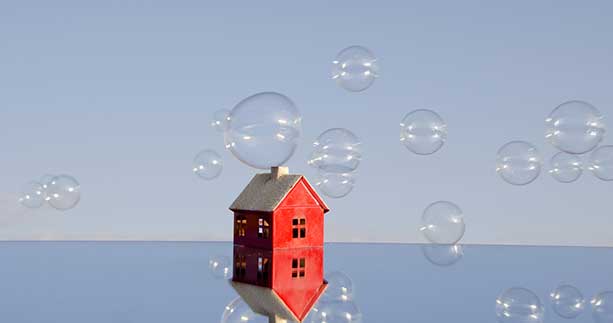Many housing industry experts and economists (especially “celebrity economists”) have been touting their belief that the housing recovery has been very real over the past year to 18 months, and see things only getting better.
We, on the other hand, have seemingly been a rare contrarian.
For many months we have privately and publicly stated that the current housing “recovery” is an illusion – a false recovery built upon a sandy foundation above a slippery slope.
But the truth is, things are even worse.
In a recent article published by the Daily Real Estate News, (February 12, 2014 – “Rising Prices Chip Away at Housing Affordability”), evidence seems to suggest there are signs of a new housing bubble.
In the aforementioned piece it was stated that according to the National Association of Realtors’ latest quarterly report, “strong year-over-year price gains are starting to take a bite into housing affordability.” It also noted that the median single-family home price rose in 119 out of 164 metro areas in the fourth quarter of 2013, which is 73%, with 26% of those metros posting double-digit increases.
That sounds like good news on the surface of it, but when one takes into consideration that incomes for the middle class in America have not come close to keeping pace with the rise in home prices, and that interest rates are expected to rise noticeably into 2015, you see that housing affordability is being negatively impacted.
This will impact prices.
Without housing affordability there cannot be a rise in first-time buyer participation. Without the entrance of first-time buyers, those wishing (or hoping) to move up to a larger home or relocate into other neighborhoods will not be able to so, at least not readily. This can produce a cascade effect on housing prices, starting to drive them downward to reflect a decrease in demand.
In another recent article by Christopher Matthews featured in Fortune, the author poses the question, “Is the housing recovery losing steam?” Additional evidence certainly seems to answer his question in the affirmative.
According to Matthews, new home construction has severely lagged behind the growing demand for housing with only 880,000 new homes under construction in January of this year, which is 16% below the revised December estimate of 1,048,000 and 2% below the January 2013 rate of 898,000. Without the accompanying job growth created by a real, sustainable increase in new housing starts there cannot be a “real” housing recovery.
These numbers above, along with continued dismal employment figures should sound alarm bells. In addition, much of the rise in home prices is also due to the participation of large and even smaller investors who have entered or are now entering the new REO-to-rental or long-existing single-family rental market.
Many of these hedge funds or individual investors paid higher than listing prices in order to secure these properties. By doing so, believing that purchasing homes above list price but below replacement cost would be a wise investment, available homes went to investors, not owner-occupants.
This practice, in addition to the government’s continuing efforts to modify loans and stall the foreclosure process has contributed to over-inflated home “values.” If housing prices begin to fall, wouldn’t one expect the investors to at least consider dumping homes onto the market to minimize potential losses? If they did so, the aforementioned cascade-effect would drive prices down even further.
If that isn’t enough to convince you that we may be seeing another housing bubble, consider the fact that traditional mortgage lenders have much stricter lending guidelines today.
This has pushed many buyers into FHA loans or even loans provided by non-banks.
In 2010 for example, over 40% of all mortgages were financed with FHA backing. It can be argued that many of these loans are riskier. Some have very low down payments or are adjustable-rate loans. Higher risk loans simply means more people have received mortgages on homes they cannot afford. That translates into more and more loans going into default. That should certainly sound familiar.
Additionally, millions of loans that went through the Home Affordable Modification Program are soon to be recast. Some economists are predicting that 30% or more of those loans will go back into default. Many others believe that government agencies will not let that happen. If those economists who believe the government will continue to intervene are right, the outcome would further fuel a false demand for available housing – once again prolonging the inevitable. But will this government or even a new one want to step in again to bail out consumers?
Haven’t we learned anything over the past five years? Much of what we covered here contributed to the housing crash of 2008, and an artificial recovery. Surely I am not the only one who sees this latest bubble coming – perhaps not simmering up to the boiling point as did the last one, but a bubble nonetheless.




